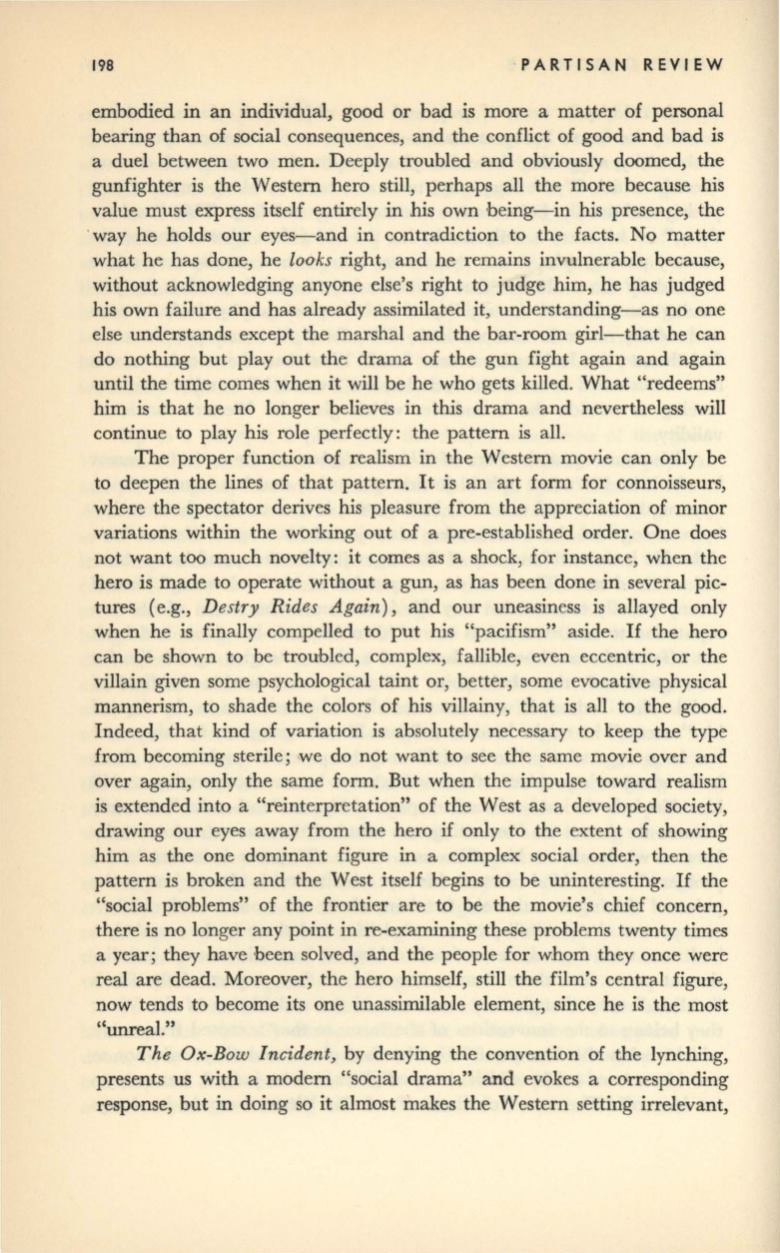
198
PARTISAN REVIEW
embodied in an individual, good or bad is more a matter of personal
bearing than of social consequences, and the conflict of good and bad is
a duel between two men. Deeply troubled and obviously doomed, the
gunfighter is the Western hero still, perhaps all the more because his
value must express itself entirely in his own being-in his presence, the
'way he holds our eyes-and in contradiction to the facts. No matter
what he has done, he
looks
right, and he remains invulnerable because,
without acknowledging anyone else's right to judge him, he has judged
his own failure and has already assimilated it, understanding-as no one
else understands except the marshal and the bar-room girl-that he can
do nothing but play out the drama of the gun fight again and again
until the time comes when it will be he who gets killed. What "redeems"
him is that he no longer believes in this drama and nevertheless will
continue to play his role perfectly: the pattern is all.
The proper function of realism in the Western movie can only be
to deepen the lines of that pattern. It is an art form for connoisseurs,
where the spectator derives his pleasure from the appreciation of minor
variations within the working out of a pre-established order. One does
not want too much novelty: it comes as a shock, for instance, when the
hero is made to operate without a gun, as has been done in several pic–
tures (e.g.,
Destry Rides Again),
and our uneasiness is allayed only
when he is finally compelled to put his "pacifism" aside.
If
the hero
can be shown to be troubled, complex, fallible, even eccentric, or the
villain given some psychological taint or, better, some evocative physical
mannerism, to shade the colors of his villainy, that is all to the good.
Indeed, that kind of variation is absolutely necessary to keep the type
from becoming sterile; we do not want to see the same movie over and
over again, only the same form. But when the impulse toward realism
is extended into a "reinterpretation" of the West as a developed society,
drawing our eyes away from the hero if only to the extent of showing
him as the one dominant figure in a complex social order, then the
pattern is broken and the West itself begins to be uninteresting.
If
the
"social problems" of the frontier are to be the movie's chief concern,
there is no longer any point in re-examining these problems twenty times
a year; they have been solved, and the people for whom they once were
real are dead. Moreover, the hero himself, still the film's central figure,
now tends to become its one unassimilable element, since he is the most
"unreal."
The Ox-Bow Incident,
by denying the convention of the lynching,
presents us with a modem "social drama" and evokes a corresponding
response, but in doing so it almost makes the Western setting irrelevant,


